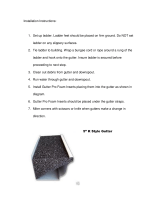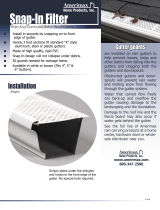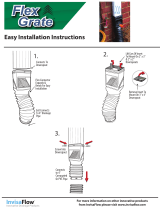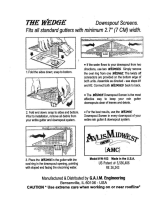Page is loading ...

NELSON
™
HEAT TRACING SYSTEMS
ROOF & GUTTER DEICING SYSTEM INSTALLATION
FOR TYPE SLT AND CLT-JT HEATING CABLE & ACCESSORIES INSTRUCTIONS
P. O. BOX 726 TULSA, OK 74101 TEL 918-627-5530 FAX 918-641-7336 www.nelsonheaters.com
GA-2252 Rev. 3
Sheet 1 of 4
September 2005
DESCRIPTION
Nelson Heat Tracing Systems’ SLT and CLT-JT heater cables provide a solution for ice dams that can
build up and damage buildings and gutter systems. The cables' self-regulation feature provides additional
benefits:
• Lower Energy Consumption - the cable reduces its power output as the ice and snow disappear.
• Fail-Safe Temperature Limit - the cable cannot overheat and melt or damage temperature sensitive roof
coatings.
COMPONENTS
SLT-LPS Power Connection Kit- includes moisture seals for both ends of the heater cable as well as a
watertight entry seal into a junction box (not included in this kit). It is recommended that a NEMA 3R, 4 or
4X box be used and mounted under an eave or other protected area. Each kit will terminate one heater cable.
SLT-ES Entry Seal Kit- provides a watertight entry seal into a junction box (not included in this kit). It is
recommended that a NEMA 3R, 4 or 4X box be used and mounted under an eave or other protected area.
One entry per kit.
SLT-C Universal Roof Mounting Clips- are used for all types of installations. Clips come 25 to a box;
order one box per eight feet of eave or one box for every 100 feet of cable installed on flat roofs.
SLT-D- Downspout Hangars are used to support the heater cable where it enters or exits a downspout.
Hangars come in kits of 5; one is required for each downspout. If downspout is in the middle of a circuit, the
cable is looped down to the bottom of drain and back up, clamping it into downspout hanger to prevent the
cable from being pulled tight against drain/gutter edge. Each kit contains 5 hangars.
SLT-S Splice Kit- is used to splice two pieces of cable together. This could occur when additional cable is
needed or a damaged spot must be cut out and repaired. Each kit contains 5 splices.
SLT-E End Seal Kit- provides a moisture seal at the end of each heater cable circuit. Each kit contains 5
seals.
SLT-P Power End Seal Kit- provides a moisture seal at the power connection end of the heating cable to
prevent electrical arcing if condensation occurs in the connection box. Each kit contains 5 seals.
AT-50 Aluminum Foil Tape- may be used to secure the heater cable to the bottom of the gutter. Each roll of
tape will accommodate 46M (150’) of gutter. Gutter must be clean for foil tape to adhere properly. As an
alternate, the cable may be laid loose in the bottom of the gutter without being secured with foil tape.

NELSON
™
HEAT TRACING SYSTEMS
ROOF & GUTTER DEICING SYSTEM INSTALLATION
FOR TYPE SLT AND CLT-JT HEATING CABLE & ACCESSORIES INSTRUCTIONS
P. O. BOX 726 TULSA, OK 74101 TEL 918-627-5530 FAX 918-641-7336 www.nelsonheaters.com
GA-2252 Rev. 3
Sheet 2 of 4
September 2005
INSTALLATION INSTRUCTIONS
Before installing heater cable, allow it to warm up to room temperature. Keep grommets and
shrink tube warm until needed. (keep inside of jacket pocket.)
Clear all gutters and downspouts of debris. (protect hands with gloves).
Remove any sharp edges that could damage the heater cable.
Mount weatherproof junction box in a sheltered area.
Start heater cable installation at the junction box, leaving a drip loop where the cable exits the
junction box.
Terminate heater cable per instructions and connect to power wiring with supplied wire nuts.
It is recommended that the heater cable be megger tested between bus wires and ground braid after
installation to verify cable integrity. Heater cable should have a minimum insulation resistance of
20 megohms when tested with at least a 500VDC megger, a 2500VDC megger is preferred.
The circuit breaker can be used to turn the heater cable off and on. Optionally, an automatic snow
or ice detector may be used to control the cable.
Ò Two copies of a caution notice indicating the presence of electric deicing and snow melting
equipment on the premises are included in the power connection/entry seal kits. One notice must
be posted at the circuit breaker panel and the other notice posted next to the control device. Both
notices must be clearly visible.
!
WARNINGS:
• Article 426 of the National Electric Code requires that all outdoor electric deicing and
snow-melting equipment be provided with branch circuit ground-fault equipment
protection.
• Moisture must be kept away from the live electrical parts of the cable or electrical faults
will develop.
• If nuisance tripping of ground-fault breakers occurs due to condensation in the junction
box, electrical connections should be moisture proofed by use of a coating or sealant.
• The cables ground braid must be connected to electrical ground for proper protection
through circuit breakers. All electrical connections should be made by a licensed
electrician.
• Do not twist bus wires together – this will result in a short circuit and damage the cable.
• Damaged heater cables must be repaired or replaced.
• Avoid laying ladders against the heater cable.
• Before energizing the circuit each season, make sure that the gutter system and
downspouts are free of leaves and debris.

NELSON
™
HEAT TRACING SYSTEMS
ROOF & GUTTER DEICING SYSTEM INSTALLATION
FOR TYPE SLT AND CLT-JT HEATING CABLE & ACCESSORIES INSTRUCTIONS
P. O. BOX 726 TULSA, OK 74101 TEL 918-627-5530 FAX 918-641-7336 www.nelsonheaters.com
GA-2252 Rev. 3
Sheet 3 of 4
September 2005
Cable Clip (SLT-C)
Heater Cable
(shall not bulge or be visible)
Gutter Detail
Heater Cable
Aluminum Tape
(optional)
Drip Loop
End of Circuit
End Seal
(should not be submerged nor
bottom end of a downspout)
Downspout Installation
be allowed to be at the at the
Downspout Hanger Detail
Hanger Wire
Nail or other support
End Seal
Clamps
Protective Tubing
Heater Cable
Downspout
(SLT-D)
(SLT-E)
Conduit
Junction Box
(not included in kit)
Cable Connector (SLT-ES)

NELSON
™
HEAT TRACING SYSTEMS
ROOF & GUTTER DEICING SYSTEM INSTALLATION
FOR TYPE SLT AND CLT-JT HEATING CABLE & ACCESSORIES INSTRUCTIONS
P. O. BOX 726 TULSA, OK 74101 TEL 918-627-5530 FAX 918-641-7336 www.nelsonheaters.com
GA-2252 Rev. 3
Sheet 4 of 4
September 2005
Cable Clip (SLT-C)
Roof
Heater Cable
Roofing Nail
Silicone Sealant
Asphalt/Shake Shingle Roof - Fasten with nail, coat
nail head and upslope edge of clip with silicone sealant.
Cable Clip (SLT-C)
Heater Cable
Metal Screw
Gutter
Heater Cable
Cable Clip
#
8-32 Screw & Nu
t
Pipe Strapping
Peg under Tile
Gutter
(SLT-C)
Tile Roof - Use perforated pipe strapping to attach the
clips to the roof. For new construction, the strapping
should be secured to the wooden substructure by means
of pegging or nailing as the roof tiles are installed. For
existing tile roofs, a bead of adhesive (not furnished)
should run along the perforated strapping for a length of
76mm (3”) prior to slipping the strapping up under the
tile. Do not use an excessive amount so as to leave a
visible blob of adhesive on the outer edge of the tile.
The adhesive bead should be large enough to deform and
smear along the underneath surface of the tile. Allow
the adhesive cure to full bonding strength before
attempting to install the cable and clips
.
(SLT-C)
Heater Cable
Heater Cable
Gutter
Washer
Heater Cable
Cable Clip
Roof
(in bottom of gutter)
Cable Clip
Metal Roof - Fasten with sheet metal screw using
neoprene sealing washer. If washers are not available,
coat screw and upslope edge of clip with silicone
sealant. Exact cable spacing may vary depending on the
rib design of the roof. Typically trace every other rib.
Hardware Cloth
#8 x 1/2" Long Pan Head Screw
Heater Cable
#8 Hex Nut
Cable Clip (SLT-C)
6.34mm (.25") max. Grid
Flat Roof - Adhesive (not furnished) should be used to
bond clips studs to the flat surface. The roof surface
should be clean at the bonding locations. Do not
penetrate flat roofs with screws or nails as leaks may
develop. Allow the adhesive to cure to full bonding
strength before attempting to install the cable and clips.
Nelson Heat Tracing Systems products are supplied with a limited warranty. Complete Terms and Conditions may be found on Nelson's
website at
www.nelsonheaters.com.
/








